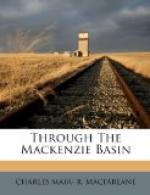The country passed through showed good soil wherever we penetrated the hay margin, with, of course, here and there the customary muskegs. The stream now narrowed into a passage deep but barely wide enough for our canoes, our course lying always through tall and luxuriant hay. At last we reached Pelican Lake, a pretty large sheet of water, about three miles across, the body of the lake extending to the south-west and north-east. We crossed it under sail and, landing at the “three mile portage,” found a half-breed there with a cart and ponies, which took our outfit over in a couple of trips to Sandy Lake. A very strong headwind blowing, we camped there for the night.
This lake is the height of land, its waters discharging by the Wahpooskow River, whose northern part, miscalled the Loon, falls into the Peace River below Fort Vermilion. The lake is an almost perfect circle, ten or twelve miles in diameter, the water full of fibrous growths, with patches of green scum afloat all over it. Nevertheless, it abounds in pike, dory, and tullabees, the latter a close congener of the whitefish, but finer in flavour and very fat. Indeed, the best fed dogs we had seen were those summering here. The lake, where we struck it, was literally covered with pin-tail ducks and teal; but it is not a good moose country, and consequently the food supply of the natives is mainly fish.
We descried a few half-breed cabins and clearings on the opposite shore, carved out of the dense forest which girdles the lake, and topographically the country seemed to be of a moderate elevation, and well suited for settlement. The wind having gone down, we crossed the lake on the 2nd of September to what is here called Sandy Creek, a very crooked stream, its thick, sluggish current bordered by willows and encumbered with reeds and flags, and, farther on, made a two-mile portage, where at a very bad landing we were joined by the boats, and presently paddled into a great circular pond, covered with float-weed, a very paradise of ducks, which were here in myriads.




